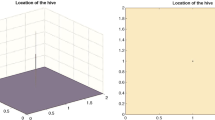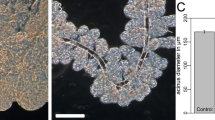Abstract
We develop a model of honey bee colony collapse based on the contamination of forager bees in environmental regions contaminated with pesticides. An important feature of the model is the daily homing capacity each day of foragers bees. The model consists of difference equations describing the daily homing of uncontaminated and contaminated forager bees, with an increased homing failure of contaminated bees. The model quantifies colony collapse in terms of the fraction of contaminated bees subject to this increased homing failure. If the fraction is sufficiently high, then the hive falls below a viability threshold population size that leads to rapid disintegration. If the fraction is sufficiently low, then the hive can rise above the viability threshold and attain a stable population level.








Similar content being viewed by others
References
Abou-Shaara HF (2014) The foraging behaviour of honey bees, Apis mellifera: a review. Vet Med 59(1):1–10
American Society for Horticultural Science, U.S. states begin ban on neonicotinoids (2019) https://ashs.org/blogpost/1288786/251171/
Banks HT, Banks JE, Bommarco R et al (2017) Modeling bumble bee population dynamics with delay differential equations. Ecol Model 351:14–23
Barron AB (2015) Death of the bee hive: understanding the failure of an insect society. Sci Direct 10:45–50
Becher MA, Osborne JL, Thorbek P et al (2013) Towards a systems approach for understanding honeybee decline: a stocktaking and synthesis of existing models. J Appl Ecol 50:868–880
Becher MA, Grimm V, Thorbek P et al (2014) BEEHAVE: a systems model of honeybee colony dynamics and foraging to explore multifactorial causes of colony failure. J Appl Ecol 51:470–482
Becher MA, Twiston-Davies G, Penny TD (2018) Bumble-BEEHAVE: a systems model for exploring multifactorial causes of bumblebee decline at individual, colony, population and community level. J Appl Ecol 55:2797–2801
Bee Informed Partnership, Total US managed honey bee colonies loss estimates (2018) https://beeinformd.org
Bernardi S, Venturino E (2016) Viral epidemiology of the adult Apis Mellifera infested by the Varroa destructor mite. Sci Direct 5:e00101
Betti MI, Wahl LM, Zamir M (2014) Effects of infection on honey bee population dynamics: a model. PLoS ONE 9(10):e110237
Betti M, LeClair J, Wahl LM et al (2017) Bee++: an object-oriented, agent-based simulator for honeybee colonies. Pop Sci 8:31
Blacquiére T, Smagghe G, van Gestel CAM et al (2016) Neonicotinoids in bees: a review on concentrations, side-effects and risk assessment. Ecotoxicology 21(4):973–992
Booten RD, Iwasa Y, Marshall JAR et al (2017) Stress-mediated Allee effects can cause the sudden collapse of honey bee colonies. J Theor Biol 420:213–219
Bryden J, Gill RJ, Mitton RAA et al (2013) Chronic sublethal stress causes bee colony failure. Ecol. Lett 16:1463–1469
Chauzat M-P, Carpentier P, Martel A-C et al (2009) Influence of pesticide residues on honey bee (Hymenoptera: Apidae) colony health in France. Environ Entomol 38(3):514–543
Cutler GC, Scott-Dupree CD (2007) Exposure to clothianidin seed-treated canola has no long-term impact on honey bees. J Econ Entomol 100(3):765–772
Cutler GC, Scott-Dupree CD, Sultan M et al (2014) A large-scale field study examining effects of exposure to clothianidin seed-treated canola on honey bee colony health, development, and overwintering success. Peer J 2:e652
Cutler GC, Scott-Dupree CD (2016) A field study examining the effects of exposure to neonicotinoid seed-treated corn on commercial bumble bee colonies. Ecotoxicology 23(9):1755–1763
DeGrandi-Hoffman G, Roth SA, Loper GL, Erickson EH (1989) BEEPOP: a honeybee population dynamics simulation model. Ecol Model 45:133–150
DeGrandi-Hoffman G, Curry R et al (2004) A mathematical model of Varroa mite (Varroa destructor Anderson and Trueman) and honeybee Apis mellifera L. population dynamics. Int J Acarol 30(3):259–274
Dennis B, Kemp WP (2016) How hives collapse: Allee effects, ecological resilience, and the honey bee. PLoS ONE 11(2):e0150055
Desneux N, Decourtye A, Delpuech JM (2007) The sublethal effects of pesticides on beneficial arthropods. Annu Rev Entomol 52:81–106
Dively GP, Embrey MS, Kamel A et al (2015) Assessment of chronic sublethal effects of imidacloprid on honey bee colony health. PLoS ONE 10:e0118748
Dukas R (2008) Mortality rates of honey bees in the wild. Insectes Sociaux 55(3):252–255
European Food Safety Authority, Neonicotinoids: risks to bees confirmed (2018) https://doi.org/10.2903/sp.efsa.2018.EN-1378
European Food Safety Authority, Evaluation of the data on clothianidin, imidacloprid and thiamethoxam for the updated risk assessment to bees for seed treatments and granules in the EU (2018) https://doi.org/10.2903/sp.efsa.2018.EN-1378
Farley JD (2017) Evolutionary dynamics of bee colony collapse disorder: steps toward a mathematical model of the contagion hypothesis. J Adv Agric 7(2):1050–1056
Gabbriellini G (2017) Seasonal effects on honey bee population dynamics: a nonautonomous system of difference equations. Int J Differ Equ 12(2):211–233
Goulson D, Nicholls E, Botas C, Rotheray EL (2015) Bee declines driven by combined stress from parasites, pesticides, and lack of flowers. Science 347:1255957
H.R. 3040-Saving America’s Pollinators Act of 2017 (2018) https://www.congress.gov/bill /115th-congress/house-bill/3040/text
Henry M, Béguin M, Requier F et al (2012) A common pesticide decreases foraging success and survival in honey bees. Science 336(6079):348–350
Henry M, Cerrutti N, Aupinel P et al (2015) Reconciling laboratory and field assessments of neonicotinoid toxicity to honeybees. Proc R Soc B Sci 282:20152110
Huang ZY, Robinson GE (1974) Regulation of honey bee division of labor by colony age demography. Behav Ecol Sociobiol 39:147–158
Kang Y, Theraulaz G (2016) Dynamical models of task organization in social insect colonies. Bull Math Biol 78(5):879–915
Kang Y, Blanco K, Davis T, Wang Y, DeGrandi-Hoffman G (2016) Disease dynamics of honeybees with Varroa destructor as parasite and virus vector. Math Biosci 275:71–92
Khoury DS, Myerscough MR, Barron AB (2011) A quantitative model of honey bee colony population dynamics. PLoS ONE 6(4):e18491
Kribs-Zaleta CM, Mitchell C (2014) Modeling colony collapse disorder in honeybees as a contagion. Math Biosci Eng 11(6):1275–1294
Leoncini I, Le Conte Y, Costagliola G et al (2004) Regulation of behavioral maturation by a primer pheromone produced by adult worker honey bees. Proc Nat Acad Sci 101:17559–17564
Martin SJ (2002) The role of Varroa and viral pathogens in the collapse of honeybee colonies: a modeling approach. J Appl Ecol 38:1082–1093
Meikle WG, Adamczyk JJ, Weiss M et al (2016) Sublethal effects of imidacloprid on honey bee colony growth and activity at three sites in the US. PLoS ONE 11:e0168603
Myerscough MR, Khoury DS, Ronzani S, Barron AB (2017) Why do hives die? Using mathematics to solve the problem of honey bee colony collapse. In: Anderssen B et al (eds) The role and importance of mathematics in innovation. Mathematics for industry, vol 25. Springer, Singapore
Nguyen BK, Saegerman C, Picard C et al (2009) Does imidacloprid seed-treated maize have an impact on honey bee mortality? J Econ Entomol 102(2):616–623
Pilling E, Cambell E, Coulson M et al (2013) A four-year field program investigating long-term effects of repeated exposure of honey bee colonies to flowering crops treated with thiamethoxam. PLoS ONE 8:e77193
Ratti V, Kevan PG, Eberl HJ (2013) A mathematical model for population dynamics in honeybee colonies infested with Varroa destructor and the acute bee paralysis virus. Can Appl Math Q 21(1):63–93
Ratti V, Kevan PG, Eberl HJ (2015) A mathematical model of the honeybee-Varroa destructor-Acute bee paralysis virus system with seasonal effects. Bull Math Biol 77(8):1493–1520
Ratti V, Kevan PG, Eberl HJ (2017) A mathematical model of forager loss in honeybee colonies infested with Varroa destructor and the acute bee paralysis virus. Bull Math Biol 79(6):1218–1253
Rolke D, Fuchs S, Grunewald B et al (2016) Large-scale monitoring of effects of clothianidin-dressed oilseed rape seeds on pollinating insects in Northern Germany: effects on honey bees (Apis mellifera). Ecotoxicology 25(9):1648–1665
Rundlof M, Andersson GKS, Bommarco R et al (2015) Seed coating with a neonicotinoid insecticide negatively affects wild bees. Nature 521:77–80
Russell S, Barron AB, Harris D (2013) Dynamic modelling of honey bee (Apis mellifera) colony growth and failure. Ecol Model 265(10):158–169
Sandrock C, Tanadini LG, Pettis JS et al (2014) Sublethal neonicotinoid insecticide exposure reduces solitary bee reproductive success. Agric For Entomol 16:119–128
Schmickl T, Crailsheim K (2007) HoPoMo: a model of honeybee intracolonial population dynamics and resource management. Ecol Model 204:219–245
Schneider CW, Tautz J, Grünewald B et al (2012) RFID tracking of sublethal effects of two neonicotinoid insecticides on the foraging behavior of Apis mellifera. PLoS ONE 7(1):e30023
Stanley DA, Russell AL, Morrison SJ et al (2016) Investigating the impacts of field-realistic exposure to a neonicotinoid pesticide on bumblebee foraging, homing ability and colony growth. J Appl Ecol 53:1440–1449
Sumpter DJ, Martin SJ (2004) The dynamics of virus epidemics in Varroa-infested honey bee colonies. J Animal Ecol 73(1):51–63
Thompson HM, Wilkins S, Harkin S et al (2015) Neonicotinoids and bumblebees (Bombus terrestris): effects on nectar consumption in individual workers. Pest Manag Sci 71(7):946–950
Torres DJ, Ricoy UM, Roybal S (2015) Modeling honey bee populations. PLoS ONE 10(7):e0130966
Truitt LL, McArt SH, Vaughn AH, Ellner SP (2019) Trait-based modeling of multihost pathogen transmission: plant-pollinator networks. Am Nat 193(6):E149–E167
United States Department of Agriculture Agricultural Research Service (2019) https://www.ars.usda.gov/oc/br/ccd/index/
United States Environmental Protection Agency, Schedule for Review of Neonicotinoid Pesticides (2019) https://www.epa.gov/pollinator-protection/schedule-review-neonicotinoid-pesticides
vanEngelsdorp D, Evans JD, Saegerman C et al (2009) Colony collapse disorder: a descriptive study. PLoS ONE 4(8):e6481
Wikepedia (2019) https://en.wikipedia.org/wiki/Colony_collapse_disorder
Willkinson D, Smith GC (2002) A model of the mite parasite, Varroa destructor, on honeybees (Apis mellifera) to investigate parameters important to mite population growth. Ecol Model 148:263–275
Acknowledgements
The authors express thanks to Dr. Frederic Barraquand, CNRS, IMB Bordeaux, France, for helpful assistance in the biological background of this work.
Author information
Authors and Affiliations
Corresponding author
Ethics declarations
Conflict of interest
The authors declare that they have no conflict of interest.
Additional information
Publisher's Note
Springer Nature remains neutral with regard to jurisdictional claims in published maps and institutional affiliations.
Rights and permissions
About this article
Cite this article
Magal, P., Webb, G.F. & Wu, Y. An Environmental Model of Honey Bee Colony Collapse Due to Pesticide Contamination. Bull Math Biol 81, 4908–4931 (2019). https://doi.org/10.1007/s11538-019-00662-5
Received:
Accepted:
Published:
Issue Date:
DOI: https://doi.org/10.1007/s11538-019-00662-5




